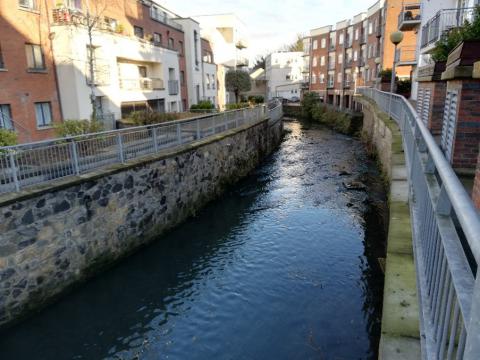Hydromorphology and Restoration Study of the River Camac, Dublin
Location: Dublin, Ireland
Client: AECOM on behalf of Dublin City Council, South Dublin County Council, and OPW
Challenge
The River Camac is one of the most modified river catchments in Dublin, with extensive hydromorphological changes extending back through centuries to accommodate milling, agriculture, and urban expansion. This has resulted in a degraded river ecosystem with impacts on fish, plant, and invertebrate species, causing some parts of the River Camac catchment to be classified as “Poor” Ecological Status under the EU Water Framework Directive.
The River Camac catchment also suffers from flooding which impacts heavily populated areas near the city centre including large areas of Kilmainham and Clondalkin.
Dublin City Council and South Dublin County Council, in collaboration with the Office of Public Works, seeks to develop a Flood Alleviation Scheme that supports the river ecosystem by restoring natural processes alongside providing flood relief.
Solution
JBA worked in consultation with the River Restoration Centre (UK) to complete a hydromorphological study focused on identifying pressures on the river ecosystem and their consequential impacts on hydromorphology and ecology. Using the results of the field work campaign, which included a fluvial audit of the entire catchment, JBA were able to prioritise certain river reaches on the Camac for restoration which would improve the ecological status of the river. This included measures such as re-meandering of the river, planting of native species in the riparian zone, and removal of artificial materials such as concrete from the river bed.
Benefit
The Hydromorphology Study serves a number of purposes to assist in the development of the FAS. The results of the data collection exercise present a robust evidence on the hydromorphological baseline of the River Camac and its main tributaries. This will assist engineers in the development of the appropriate flooding relief solutions for each section of the river.
Recommended river restoration measures and options that have been presented can be implemented to improve hydromorphological condition of the River Camac, to contribute to achieving Good status under the Water Framework Directive (WFD) alongside flood relief options.
In addition, this study can be used to better understand the surface water dynamics of the catchment including appropriate locations for SUDS and other green infrastructure developments.





